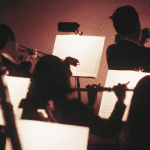The voice, with its unparalleled ability to express a wide range of emotions and connect on a deeply personal level, stands out in the musical instrument realm. This article delves into the emotional range and unique expressiveness of the human voice, exploring its capacity as an instrument of connection through vocal expressiveness, voice modulation, tone of voice, and the techniques to master these aspects. It highlights the importance of vocal music’s development, showcasing how vocals transcend music genres and create an unmatched impact. Through vocal training, singers can master the art of vocal expression, using their voice’s emotive power to convey stories and emotions that deeply resonate with listeners.
The Emotional Range of the Human Voice
The human voice has a remarkable ability to modulate emotions, making it a powerful tool for emotional expression in vocal performances. Breath control and the transformation of the speaking voice, developed through singing lessons, enhance not only the voice’s dynamism but also its expressiveness. This allows singers to convey a broader spectrum of emotions, from joy to sorrow, enriching the listener’s experience by creating a profound connection through shared emotional landscapes.
Furthermore, the voice in music acts as a powerful modulator of emotions. The complex sounds produced can reveal much about the singer, including their emotional state, beyond just age and sex. This ability to convey complex emotional states is not only a fundamental aspect of human interaction but also crucial in developing personal and cultural identity through music. The inability to detect these emotional nuances in voices is linked to significant social and psychological challenges, highlighting the voice’s role in healthy human functioning.
In the realm of vocal music, each performance is a unique expression of the singer’s personal style and cultural background. The music of the voice adds layers to a performance, creating a multi-dimensional experience that can evoke specific moods and deeply connect with the audience. This connection goes beyond the notes sung; it’s about the emotion and personal expression infused into the music by the unique timbre and modulation of the singer’s voice. Through these expressions, vocalists not only showcase their technical skills but also their ability to resonate emotionally with their audience, making each performance an intimate act of sharing.
The Complexity and Uniqueness of Vocal Expression
The human voice is a marvel of biological and neurological complexity. The motor cortex plays a crucial role in controlling voluntary vocal motor control, highlighting the intricate neural mechanisms involved in speech production. This complexity is further evidenced by humans’ unique capability to produce a diverse range of complex vocalizations, a trait that matures and modulates throughout an individual’s life. Unlike nonhuman primates and great apes, humans can modulate their vocal sounds in a way that can be methodologically analyzed and studied, especially in demanding experimental settings.
In the realm of music, the voice serves not just as an instrument but as a conduit for emotional and cultural expression. Teaching and creating music with a choir exemplifies this complexity, involving harmonizing the varied emotional sensitivities, personalities, and musical understandings of individual members. Each singer’s voice brings a unique timbre and capability to the ensemble, influenced by psychobiological and sociocultural factors. This interaction shapes the vocal expression that is fundamental not only to personal identity but also to cultural resonance.
Moreover, the therapeutic potential of vocal expression in clinical settings underscores its complexity. In therapist-patient interactions, the complexity of speech, analyzed as nonlinear time series, correlates with the emotional bond perceived by the patient. This aspect of vocal complexity not only highlights the voice’s role in emotional health but also its capacity to foster deep, interpersonal connections through nuanced and expressive vocal communication.
The Voice as an Instrument of Connection
The human voice, originating from vital centers such as the heart and lungs, is intrinsically linked to our deepest emotions and serves as a powerful medium for connection through music. Its role in classical music, treated as a sophisticated instrument capable of a wide range of sounds, showcases its versatility and expressive power. Vocalists can convey complex emotions and connect with audiences on a profound level, making each performance a unique emotional exchange.
In operatic and orchestral settings, the aria or air highlights the voice’s emotive and melodic capabilities. Characterized by lyrical qualities and the ability to shift moods and tones, these performances offer a rich tapestry of sound that resonates with cultural and historical significance. The connection forged through these performances goes beyond the notes themselves; it’s about the shared emotional journey between the performer and the audience, facilitated by the voice’s dynamic range and expressiveness.
Furthermore, the physical aspects of performance, including body language and facial expressions, play a crucial role in enhancing the connection with the audience. Effective body language, coupled with the strategic use of gestures and facial expressions, can transform a performance into a memorable experience. This is where nonverbal communication becomes a powerful tool, allowing a vocalist to truly engage with their audience. Learning from legendary performers and practicing these elements in front of a mirror can significantly enhance a vocalist’s ability to connect, making the voice a unique instrument of connection in the realm of music.
Techniques to Master Vocal Expression
Vocal training is not just a practice but a transformative journey that enhances a singer’s abilities in numerous ways. For both novices and seasoned professionals, vocal training is crucial for developing a consistent and powerful voice, increasing potential and confidence, and maintaining vocal health. It also allows singers to carve out their unique styles, essential for standing out in the competitive field of music.
Essential Vocal Techniques and Exercises 1. Breath Management and Posture
Proper posture is foundational for effective vocal training, involving standing with feet shoulder-width apart and maintaining alignment from hips to shoulders.
Diaphragmatic breathing is crucial, where singers must inhale, expanding the stomach outward, and exhale, bringing the stomach back in, to support powerful and sustained vocal output. Mastering these breathing techniques is essential for a singer’s ability to deliver powerful performances.
2. Vocal Warm-ups and Cord Care
Starting with a proper warm-up routine clears the vocal folds and increases blood flow, which is essential for flexibility and preventing injuries during performances.
Exercises such as lip trills and humming not only warm up the voice but also help in practicing pitch control and strengthening the vocal cords, serving as effective vocal bursts.Advanced Vocal Exercises
Chest voice exercises and vocal bursts help singers find their natural voice by speaking on notes and practicing five-tone scales, which bridges the gap between speaking and singing. For mastering high and low notes, vocal training exercises like sharp exhales, elocution, slides, and lip flutters are beneficial, enhancing voice projection and vocal variety.
Singers should practice scales and songs in various genres and languages to enhance their vocal flexibility and pronunciation skills, incorporating vocal bursts to improve their technique.
Professional Guidance and Long-term Development
Engaging with a professional vocal coach can elevate a singer’s training regimen by providing personalized feedback and advanced techniques, ensuring the safety and health of the vocal cords. Long-term vocal training fosters not only technical vocal improvements but also boosts confidence, provides networking opportunities, and aids in continuous musical development. These aspects are integral in shaping a singer’s career and enhancing their performance capabilities across various musical genres.
By focusing on these techniques and consistently applying them, singers can effectively use their voice as a powerful instrument of expression and connection, aligning with the overarching theme of vocal music development.
The Impact of Vocals in Different Genres of Music
Vocal characteristics and their adaptability across music genres play a pivotal role in defining the artistic and emotional impact of a song. Different voices find their niche in specific genres where they can best convey the intended emotional and musical expressions. For instance, genres like punk, rock, folk, and ballads are better suited for artists like Buck Moore, who finds these styles complement his vocal strengths, weaving in vocal bursts that resonate with various emotion categories, whereas genres such as hip hop, metal, and soul may not align as well with his vocal capabilities.
In exploring the diversity of vocal impact, it’s evident that each music genre demands a unique set of vocal qualities. Country music often emphasizes a clear, strong vocal delivery that conveys the storytelling nature of the genre, while R&B and Hip Hop focus on a more dynamic range, from smooth, melodic flows to powerful, rhythmic delivery that matches the beat and lyrical complexity. Jazz music, on the other hand, requires a high level of vocal flexibility and improvisation, allowing vocalists to engage in techniques like scat singing and call-and-response interactions with instruments, showcasing the voice’s instrumental-like capabilities and its ability to express a wide range of vocal bursts and emotion categories.
The technical aspect of ensuring vocal clarity and audibility across these genres cannot be overstated. Effective mixing and mastering practices, such as careful EQing, compression, and the judicious use of reverb and delay, are crucial in ensuring that the vocals stand out in the mix without overpowering other elements. This balance allows the vocalist’s emotional and lyrical expressions, enriched with vocal bursts and diverse emotion categories, to reach the audience with the intended impact, making the voice not only a musical instrument but a bridge to connect the artist with the listener.
Conclusion
Throughout this article, we’ve embarked on a comprehensive exploration into the realm of vocal music, highlighting the unparalleled ability of the human voice to convey a broad spectrum of emotions and connect deeply with audiences. The journey through vocal training underscores its significance not just in enhancing vocal prowess but in enriching the development of vocal music, aligning with the overarching emphasis on the progressive evolution of vocal expression across genres. The detailed analysis of techniques, from breath management to mastering vocal expressions and the impact of vocals in various music genres, culminates in recognizing the voice as the ultimate musical instrument—a vehicle for unmatched emotive expression and cultural connection.
In reflection, the exploration of vocal music’s depth and complexity invites readers to further engage with this art form, encouraging both singers and enthusiasts to delve deeper into the craft of vocal expression. As we consider the voice’s critical role in connecting and resonating with listeners across diverse musical landscapes, it becomes evident that the evolution of vocal music is an ongoing journey of discovery and innovation. For those seeking to continue this exploration and stay updated on the transformative power of vocal music, sign up to my newsletter. By fostering a deeper understanding and appreciation for vocal music, we not only celebrate its past achievements but also inspire its future development, ensuring that the human voice remains at the heart of musical expression for generations to come.







0 Comments